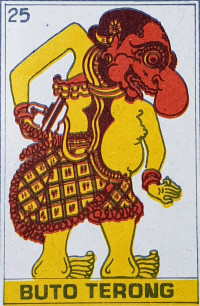Wayang Buto Terong
The Monstrous Giants of Shadow Puppetry.
In the world of Javanese wayang kulit, few figures are as intimidating and enigmatic as the Buto Terong. These monstrous giants, with their fearsome fangs, bulging eyes, and bulbous, eggplant-shaped noses, embody the forces of chaos and unbridled power that heroes must often overcome.

Appearance and Symbolism
The Buto Terong's monstrous appearance is a deliberate contrast to the refined beauty of the wayang heroes. Their exaggerated features symbolize their unrestrained appetites, violent nature, and lack of moral compass. The eggplant-shaped nose (hence "terong") is a particular marker of their grotesque and otherworldly nature.
Roles in Wayang Performances
Buto Terong often play the role of antagonists in wayang stories, representing the obstacles, both external and internal, that the Pandawa brothers or other heroes must face. They might be greedy kings dominating their people, rampaging demons threatening villages, or even personifications of negative emotions like anger or jealousy.
Physical Threats: Buto Terong engage in ferocious battles, testing the bravery and skill of the heroes.
Psychological Challenges: Their presence can symbolize the temptation of power, the seduction of greed, or the darkness that resides within even the most virtuous hearts.
Not Simply Evil
While often portrayed as villains, Buto Terong can be more nuanced than simple evildoers. Some tales depict them as misguided or capable of redemption. The complexity lies in their representation of raw power and primal instincts. This power can be destructive, but properly harnessed, it could also be a force for good.
The Power of Monsters
Buto Terong serve several important purposes within the wayang tradition:
Externalizing Conflict: They allow audiences to visualize and grapple with internal struggles or threats to society.
The Hero's Journey: Heroes are defined not merely by their strength, but by their ability to overcome the monstrous and chaotic forces within and around them.
Dramatic Spectacle: The battles between Buto Terong and the heroes are thrilling displays of puppetry skill and powerful storytelling.
Beyond the Performance
The figure of the Buto Terong has echoes in Javanese folklore and psychology. They can represent the dangers of unchecked desire, the importance of controlling one's inner demons, and the constant struggle between order and chaos within the human psyche.
The Buto Terong are an essential element in the rich tapestry of wayang kulit. They represent the darker side of human nature, embodying the wild forces that both threaten and define us. By confronting these monsters, both on stage and within ourselves, we are reminded of the importance of courage, self-control, and the eternal struggle for balance.
Last updated